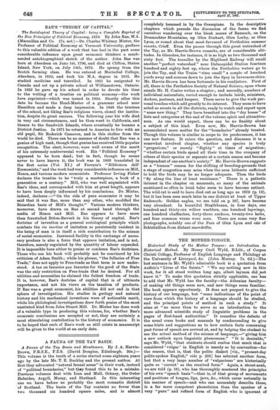A FAUNA OF THE TAY BASIN.
Fauna of the Tay Basin and Strathmore. By J. A. Harvie- Brown, F.R.S.E, F.Z.S. (David Douglas, Edinburgh. 30s.)— This volume is the tenth of a series started some eighteen years ago by the late Mr. T. E. Buckley and the present author. At first they advocated "natural faunal areas" in their work, instead of "political boundaries," but tjaey found this to be a mistake. Previous volumes deal with' Iona and Mull, Orkney, the Outer Hebrides, Argyll, Moray, and Shetland. In this interesting one we have before us probably the most romantic district of Scotland. The basin of the Tay contains no fewer than two thousand six hundred square miles, and is almost
completely hemmed in by the Grampians. In the descriptive chapters which precede the discussion of the fauna we find ourselves wandering over the bleak moors of Rannoch, on the Drumochter Mountains, up Glen Dochart, Glen Lochy, or Glen Lyon, or round about that most favoured of Perthshire summer resorts, Crieff. Even the passes through this great watershed of the Tay, as Mr. Harvie-Brown remarks, are of considerable alti- tudes. In Glenshee, for instance, it is as high as two thousand and sixty feet. The traveller by the Highland Railway will recall another "perfect watershed" near Dalnaspidal Station fourteen hundred and eighty feet up, where the Perthshire waters go to join the Tay, and the Truhn "rises small" a couple of hundred yards away and courses down to join the Spey in Inverness-shire. Mr. Harvie-Brown has been fortunate in his coadjutors. First of all, there is the Perthshire Society of Natural Science, upon whose annals Mr. H. Coates writes a chapter ; and secondly, numbers of individual naturalists, varied enough to include lairds, ministers, doctors, postmen, and keepers. These serve to give the work per- sonal touches which add greatly to its interest. They seem to have acted as scouts in all the districts, ready to watch and report upon "some new thing." They have breathed into the "dry bones" of lists and categories at the end of the volume spirit and attractive- ness. As one would expect, there can be no finality about a subject of this kind. Even now, Mr. Harvie-Brown has accumulated more matter for the "boundaries" already treated. Though this volume is similar in scope to its predecessors, it has one new feature. It raises the question, and discusses it in a somewhat involved chapter, whether any species is truly "gregarious," or merely "flighty" at times of migration ; "whether certain birds spend all their time in the company of others of their species or separate at a certain season and become independent of one another's society." Mr. Harvie-Brown suggests as a "human" reason for the shifting of breeding-gronnds that a stage of congestion may arise when the area hitherto sufficient to hold the birds may be no longer adequate. Then the birds "fly along the line of least resistance." There is a pathetic interest in the chapter on mammals, as many of the animals mentioned so often in local tales seem to have become extinct. The wild cat is said to have died out as long ago as 1870 (p. 13), but it has been seen much later in one district at least of Upper Badenoch: Golden eagles, we are told on p. 187, have become very abundant. In beautiful Strathbman, in four days, one hundred and thirty-six willow warblers, one hundred lapwings, one hundred chaffinches, forty-three cuckoos, twenty-two larks, and four common wrens were seen. There are some very fine photographs, notably one of the Pass of Glen Lyon and 01i0 of Schiehallion from distant snowdrifts.


























































 Previous page
Previous page